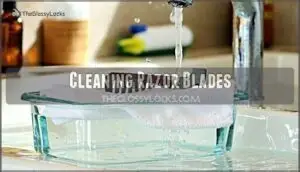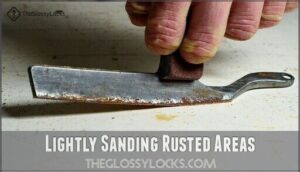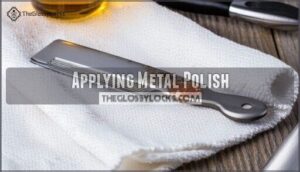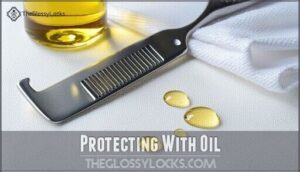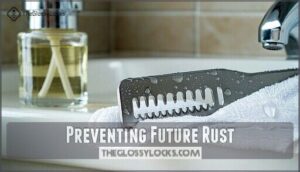This site is supported by our readers. We may earn a commission, at no cost to you, if you purchase through links.
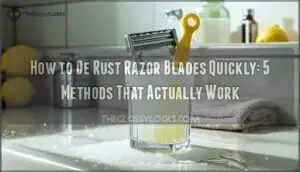 Rusty razor blades don’t have to end up in the trash.
Rusty razor blades don’t have to end up in the trash.
You can restore them quickly with household items.
White vinegar works like magic – soak your blade for 30 seconds to dissolve light rust, or leave it several minutes for stubborn spots.
For tougher cases, create a paste with baking soda and water, scrub gently, then rinse thoroughly.
Lemon juice mixed with salt also cuts through corrosion effectively.
After cleaning, dry completely and store properly to prevent future rust.
These simple tricks can save money and extend blade life substantially.
The key lies in understanding what causes rust formation and mastering prevention techniques to achieve rust-free blades with magic solutions.
Table Of Contents
- Key Takeaways
- Razor Rust Causes
- De Rust Razor Blades
- Cleaning Razor Blades
- Removing Rust Spots
- Preventing Future Rust
- Frequently Asked Questions (FAQs)
- What is the easiest way to remove rust quickly?
- Why do razor blades rust so quickly?
- What removes rust from a blade?
- How do you get rust off a razor blade?
- How to stop razor blades from rusting?
- Why did my razor rust so fast?
- Can I use WD-40 on my electric shaver?
- Can I use rust remover chemicals on my razor blades?
- How often should I replace my razor blades?
- Can I sharpen my de-rusted razor blades at home?
- Conclusion
Key Takeaways
- White vinegar is your go-to solution – Soak your blade for 30 seconds to dissolve light rust, or leave it for several minutes for stubborn spots, then scrub gently with an old toothbrush.
- Create a baking soda paste for tough rust – Mix baking soda with water to form a paste, scrub the rusted areas gently, then rinse thoroughly and dry completely to prevent flash-rusting.
- Prevention beats restoration every time – Dry your razor completely after each use, store it away from humid bathrooms, and keep blades on stands for proper air circulation.
- Replace blades every 5-7 shaves for best results – Even after removing rust, heavily corroded blades will not perform like new ones, so do not waste time on blades that are too far gone.
Razor Rust Causes
You’re not alone if you’ve found rusty spots on your razor blade after just a few uses.
Understanding what causes rust helps you prevent it and keep your blades sharp longer.
Moisture Exposure
Moisture’s your blade’s worst enemy, triggering rust formation faster than you’d expect.
Your razor’s biggest enemy? Moisture lurking in every corner of your bathroom.
High humidity levels above 60% create perfect conditions for water damage, while damp storage accelerates corrosion risk dramatically.
Bathrooms maintain elevated moisture for hours after showers, making humidity control essential for razor blade maintenance and effective rust prevention methods.
Poor Storage Practices
Where you store your razor matters more than you think.
Tossing it on a wet counter or leaving it in the shower creates the perfect storm for rust formation.
Install razor stands in well-ventilated spots away from moisture sources.
Moisture absorbers help maintain humidity control in bathroom environments, preventing rust formation before it starts.
Razor cabinets and dry storage areas protect your blades from humidity.
Low-Quality Blade Materials
Bargain blades often contain cheap alloys that rust faster than quality steel.
Cheap blades rust fast—invest in quality steel for lasting sharpness.
These inferior materials lack proper blade composition, making them vulnerable to metal corrosion within days of use.
Here are three telltale signs of poor crafting:
- Blade edges that chip or dull after just 2-3 shaves – quality steel maintains sharpness longer
- Visible discoloration appearing within a week – premium blades resist rust formation for months
- Rough, uneven surfaces that trap moisture – well-crafted blades have smooth finishes that shed water
When you’re dealing with rust removal from these subpar blades, even the best rust removal tips won’t extend their life substantially.
Prevention starts with choosing better materials that resist corrosion naturally, making razor blade restoration less frequent.
Environmental Factors
Your bathroom’s environment plays against you in the rust battle.
High humidity creates the perfect storm for corrosion, while temperature swings stress metal surfaces.
Poor air quality traps moisture around your razor, accelerating water damage.
Even your storage conditions matter – that steamy shower caddy becomes rust central.
Smart humidity control and proper ventilation transform your shaving space into a rust-free zone.
De Rust Razor Blades
Nothing’s more frustrating than discovering your trusty razor has turned into a rust bucket overnight.
When corrosion strikes, you’ve got five proven de-rusting solutions to get your blade back in fighting shape. Commercial rust removers work fastest—apply, wait ten minutes, scrub gently.
White vinegar dissolves rust in 15-30 minutes of soaking time. Citric acid solutions tackle light oxidation in under thirty minutes.
For stubborn spots, create a baking soda paste and let it work for twenty minutes before scrubbing. Fine steel wool (grade 0000) removes surface rust without damaging your blade’s edge.
Each method requires thorough rinsing and complete drying afterward to prevent flash-rusting. The key to successful razor maintenance isn’t just removing existing rust—it’s choosing the right de-rusting technique for your specific corrosion level and acting quickly before damage spreads.
Understanding proper rust removal methods is vital for maintaining your razor’s performance and extending its lifespan.
Cleaning Razor Blades
Once you’ve identified rust on your razor blade, it’s time to get cleaning.
The good news is that most rust comes off easily with the right approach and a bit of elbow grease.
Method One – Warm Water and Soap
Starting with gentle agitation, this razor cleaning method tackles early-stage rust effectively.
You’ll need liquid soap and an old toothbrush for proper blade soaking and rust removal.
- Rinse the razor under warm water to soften debris
- Apply liquid soap generously to all blade surfaces
- Scrub gently with the toothbrush to remove rust quickly
This warm water approach works best on fresh oxidation before it spreads.
Method Two – Vinegar and Baking Soda
For stubborn rust, white vinegar and baking soda make an unbeatable team.
Soak your blade in vinegar for twenty minutes, then scrub with baking soda paste.
This acid cleaning combo dissolves rust particles while the paste provides gentle abrasion.
Repeat cycles for heavily rusted blades until you achieve complete blade restoration.
The effectiveness of vinegar in cleaning relies on its use in a vinegar cleaner solution, which is a key factor in the cleaning process.
Drying and Storing Razor Blades
Proper postuse drying transforms your razor from a rust magnet into a long-lasting tool. Skip the shower storage trap—moisture’s your blade’s worst enemy.
Follow these razor drying tips for effective rust prevention:
- Rinse thoroughly with warm water to remove debris
- Pat dry completely with a clean towel or cloth
- Air dry on razor stands for ideal ventilation
- Store in dry cabinets away from bathroom humidity
Using proper razor cleaning methods is vital for maintaining hygiene and preventing rust. Smart razor storage beats constant blade replacements every time.
Removing Rust Spots
When you spot those annoying rust spots on your blade, don’t panic—they’re easier to remove than you might think.
With the right approach, you can restore your razor to near-new condition in just minutes.
Lightly Sanding Rusted Areas
Why settle for rusty blades when fine-grit sandpaper can restore them? Use 800-1,000 grit sandpaper for effective rust removal without damaging the cutting edge.
This blade refurb technique removes surface oxidation while preserving sharpness. Focus on blade flats, avoiding the razor’s cutting edge during your rust prevention routine.
Regular rust removal methods are essential for maintaining razor performance and extending blade lifespan.
| Sandpaper Grit | Rust Removal Time | Edge Protection |
|---|---|---|
| 800 Grit | 45 seconds | High safety |
| 1000 Grit | 30 seconds | Maximum protection |
| Coarse ( |
Applying Metal Polish
After sanding away the rust, metal polish restores your blade’s shine and chrome coating.
Apply a small amount of metal cleaner to a soft cloth, then work it into the blade using circular motions.
Quality rust removal methods like this help preserve the razor’s finish.
Let the polisher sit for two minutes, then buff with a clean cloth for professional blade restoration results.
Using the right metal polish products is essential for effective rust removal and blade maintenance.
Protecting With Oil
After polishing away rust spots, you’ll want to lock in that protection.
Apply a thin coat of mineral oil or specialized razor oil to create a water-repellent barrier.
This blade coating prevents future oxidation by blocking moisture and oxygen contact.
Use a clean cloth for oil application, ensuring complete coverage without excess buildup that attracts dust.
Preventing Future Rust
After cleaning rust from your blades, you’ll want to keep it from coming back like an unwelcome houseguest.
The good news is that preventing future rust is easier than removing it, and these simple habits will save you time and money in the long run, which is a complete concept to understand and these habits are simple.
Proper Blade Storage Techniques
Once you’ve removed rust spots, smart storage becomes your best defense against future problems.
Store your blades in climate-controlled areas where humidity can’t reach them.
Here are three storage solutions that work:
- Razor stands – Keep blades upright for proper air circulation and quick drying
- Blade cases with desiccants – Original packaging or protective sleeves with moisture-absorbing packets
- Vertical storage systems – Prevent warping while maintaining blade separation
Using a reliable razor stand holder can also enhance storage effectiveness.
These razor storage tips and moisture control methods will keep your blades rust-free longer.
Regular Cleaning and Maintenance Routine
You can’t set it and forget it in the context of razor care.
Daily sanitizing with rubbing alcohol kills bacteria that accelerate corrosion.
Clean your blade after each shave using gentle cleaning solutions to remove debris.
Replace blades every 5-7 shaves for peak performance.
This razor maintenance guide isn’t rocket science—consistent razor care tips prevent rust formation better than any de-rusting solutions later.
Moisture Control in Shaving Areas
Bathrooms naturally trap moisture after showers, creating a humid environment that accelerates rust formation on razor blades.
Install proper ventilation systems and run exhaust fans during shaving to improve air circulation.
Store razors on razor stands outside the bathroom for dry storage, or use moisture control solutions like silica gel packets to prevent bathroom moisture from damaging your blades.
Regular maintenance involving rust prevention methods can substantially extend the lifespan of your razor blades, which is crucial for rust prevention.
Frequently Asked Questions (FAQs)
What is the easiest way to remove rust quickly?
White vinegar dissolves rust within 15-30 minutes—just soak your blade, then scrub with an old toothbrush. You’ll break free from dull, rusty razors fast.
Why do razor blades rust so quickly?
Razor blades rust quickly because they’re constantly exposed to moisture from wet bathrooms, shaving cream residue, and trapped water droplets that accelerate oxidation.
What removes rust from a blade?
White vinegar dissolves rust fast, baking soda paste lifts stubborn spots, and lemon juice cuts through oxidation. You’ll scrub gently, rinse thoroughly, then dry completely to prevent flash-rusting.
How do you get rust off a razor blade?
Soak your blade in white vinegar for thirty seconds, then scrub gently with salt or baking soda paste. Rinse thoroughly and dry completely to prevent flash-rusting.
How to stop razor blades from rusting?
Coincidentally, most people discover rust prevention after their favorite blade’s already damaged.
Dry your razor completely after each use, store it away from humid bathrooms, and apply a light blade oil weekly to create a protective barrier against moisture.
Why did my razor rust so fast?
Your razor rusted quickly because you left it in a damp environment. Constant moisture from showers accelerates oxidation, breaking down the blade’s protective coating and causing rapid rust formation.
Can I use WD-40 on my electric shaver?
Like oil protecting a car engine from moisture damage, WD-40 can help your electric shaver’s metal parts resist rust.
You can use it sparingly on external metal surfaces, but avoid the cutting blades and motor housing to prevent performance issues.
Can I use rust remover chemicals on my razor blades?
Yes, you can use commercial rust removers on razor blades.
Choose products with oxalic or phosphoric acid for best results.
Work quickly—they remove surface rust in 10-20 minutes.
Rinse thoroughly afterward to prevent damage.
How often should I replace my razor blades?
Time flies when you’re shaving smart! Replace your razor blades every 5-7 shaves to maintain peak sharpness, prevent irritation, and avoid bacterial buildup that compromises your skin’s health.
Can I sharpen my de-rusted razor blades at home?
Sharpening de-rusted blades at home isn’t recommended.
Even gentle methods can damage the precise edge geometry, making blades duller than before.
You’ll get better results replacing blades every 5-7 shaves instead.
Conclusion
Absolutely nothing beats the satisfaction of transforming a hopelessly rusted blade into a gleaming tool again.
Learning how to de rust razor blades quickly isn’t just about saving money—it’s about mastering practical skills that’ll serve you well.
These five proven methods work because they tackle rust at the molecular level.
Whether you’re dealing with light surface oxidation or stubborn corrosion, you’ve got options.
Remember, prevention beats restoration every time, so keep those blades dry and properly stored after each use.
- https://www.leaf.tv/keep-razor-blade-rusting-10782.html
- https://www.nakedarmorazors.com/blogs/news/how-to-strop-a-straight-razor
- http://www.tripledtools.com/how-to-store-circular-saw-blades-safely-tips-for-diyers-and-contractors/
- https://bladesdirect.net/blogs/news/how-to-store-and-ship-diamond-blades?srsltid=AfmBOoqqwo6M3lPzfzWBDYRzXhYjzC0dvFYsQ2mGIW5WokK4iop5rPj6

